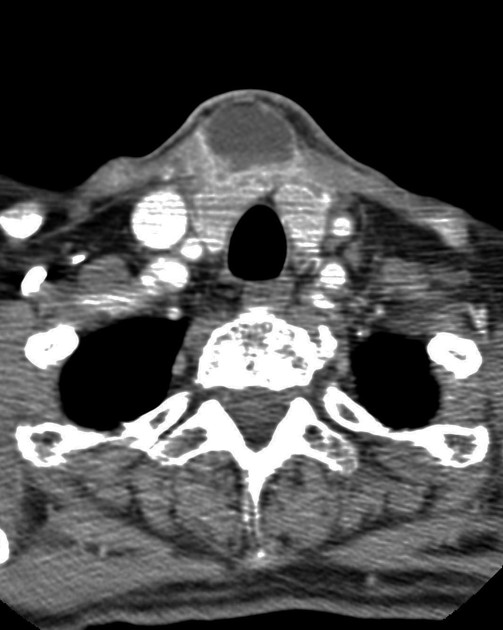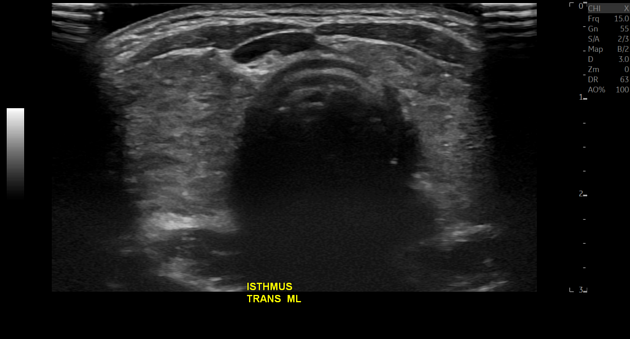Delphian lymph node
Citation, DOI, disclosures and article data
At the time the article was created Frank Gaillard had no recorded disclosures.
View Frank Gaillard's current disclosuresAt the time the article was last revised Henry Atkinson had no financial relationships to ineligible companies to disclose.
View Henry Atkinson's current disclosures- Delphian lymph node
- Precricoid node
- Precricoid lymph node
- Prelaryngeal node
- Prelaryngeal lymph node
- Delphian node
The Delphian (prelaryngeal/precricoid) lymph node (often shortened to Delphian node) is one of the cervical lymph node groups that comprise level VI cervical lymph nodes and is not routinely excised in radical neck dissections, increasing the importance of alerting surgeons to the presence of metastases in this location.
On this page:
Gross anatomy
The Delphian lymph node is located between the cricothyroid muscles, above the thyroid isthmus, lying directly anterior to the cricothyroid membrane 2,3. It receives lymph from the thyroid gland (mainly the upper poles) and the larynx 3.
History and etymology
The Delphian node was named in 1948 by Dr Randall B. Raymond, then a Harvard medical student, who theorized the importance of metastases in this nodal group in predicting a poor outcome and made an analogy with the Oracle of Delphi, whose prophecy, in this case, would be of death secondary to laryngeal cancer 5.
Related pathology
Involvement of this node can be as a result of diffuse nodal involvement in head and neck squamous cell carcinoma or in isolation from direct lymphatic spread of laryngeal cancer through the anterior commissure. Thyroid carcinomas may also involve this node, in which case it usually signifies disease spread to the central and lateral cervical lymph nodes 3,4.
Quiz questions
References
- 1. Josef E. Fischer, Kirby I. Bland, Mark P. Callery. Mastery of Surgery. (2006) ISBN: 9780781771658 - Google Books
- 2. Marco Lucioni. Practical Guide to Neck Dissection. (2013) ISBN: 9783642339776 - Google Books
- 3. Isaacs J, Lundgren C, Sidhu S, Sywak M, Edhouse P, Delbridge L. The Delphian Lymph Node in Thyroid Cancer. Ann Surg. 2008;247(3):477-82. doi:10.1097/SLA.0b013e31815efdc4 - Pubmed
- 4. Oh E, Chung Y, Lee Y. Clinical Significance of Delphian Lymph Node Metastasis in Papillary Thyroid Carcinoma. World J Surg. 2013;37(11):2594-9. doi:10.1007/s00268-013-2157-8 - Pubmed
- 5. Chen Y, Wang Y, Li C, Zhang X, Fu Y. Meta-Analysis of the Effect and Clinical Significance of Delphian Lymph Node Metastasis in Papillary Thyroid Cancer. Front Endocrinol. 2024;14:1295548. doi:10.3389/fendo.2023.1295548
Incoming Links
Related articles: Anatomy: Head and neck
- skeleton of the head and neck
-
cranial vault
- scalp (mnemonic)
- fontanelle
-
sutures
- calvarial
- facial
- frontozygomatic suture
- frontomaxillary suture
- frontolacrimal suture
- frontonasal suture
- temporozygomatic suture
- zygomaticomaxillary suture
- parietotemporal suture (parietomastoid suture)
- occipitotemporal suture (occipitomastoid suture)
- sphenofrontal suture
- sphenozygomatic suture
- spheno-occipital suture (not a true suture)
- lacrimomaxillary suture
- nasomaxillary suture
- internasal suture
- basal/internal
- skull landmarks
- frontal bone
- temporal bone
- parietal bone
- occipital bone
- skull base (foramina)
-
facial bones
- midline single bones
- paired bilateral bones
- cervical spine
- hyoid bone
- laryngeal cartilages
-
cranial vault
- muscles of the head and neck
- muscles of the tongue (mnemonic)
- muscles of mastication
-
facial muscles
- epicranius muscle
- circumorbital and palpebral muscles
- nasal muscles
-
buccolabial muscles
- elevators, retractors and evertors of the upper lip
- levator labii superioris alaeque nasalis muscle
- levator labii superioris muscle
- zygomaticus major muscle
- zygomaticus minor muscle
- levator anguli oris muscle
- malaris muscle
- risorius muscle
- depressors, retractors and evertors of the lower lip
- depressor labii inferioris muscle
- depressor anguli oris muscle
- mentalis muscle
- compound sphincter
-
orbicularis oris muscle
- incisivus labii superioris muscle
- incisivus labii inferioris muscle
-
orbicularis oris muscle
- muscle of mastication
- modiolus
- elevators, retractors and evertors of the upper lip
- muscles of the middle ear
- orbital muscles
- muscles of the soft palate
- pharyngeal muscles
- suprahyoid muscles
- infrahyoid muscles
- intrinsic muscles of the larynx
- muscles of the neck
- platysma muscle
- longus colli muscle
- longus capitis muscle
- scalenus anterior muscle
- scalenus medius muscle
- scalenus posterior muscle
- scalenus pleuralis muscle
- sternocleidomastoid muscle
-
suboccipital muscles
- rectus capitis posterior major muscle
- rectus capitis posterior minor muscle
- obliquus capitis superior muscle
- obliquus capitis inferior muscle
- accessory muscles of the neck
- deep cervical fascia
-
deep spaces of the neck
- anterior cervical space
- buccal space
- carotid space
- danger space
- deep cervical fascia
- infratemporal fossa
- masticator space
- parapharyngeal space
- stylomandibular tunnel
- parotid space
- pharyngeal (superficial) mucosal space
- perivertebral space
- posterior cervical space
- pterygopalatine fossa
- retropharyngeal space
- suprasternal space (of Burns)
- visceral space
- surgical triangles of the neck
- orbit
- ear
- paranasal sinuses
- upper respiratory tract
- viscera of the neck
- blood supply of the head and neck
-
arterial supply
-
common carotid artery
- carotid body
- carotid bifurcation
- subclavian artery
- variants
-
common carotid artery
- venous drainage
-
arterial supply
- innervation of the head and neck
-
cranial nerves
- olfactory nerve (CN I)
- optic nerve (CN II)
- oculomotor nerve (CN III)
- trochlear nerve (CN IV)
-
trigeminal nerve (CN V) (mnemonic)
- trigeminal ganglion
- ophthalmic division
- maxillary division
- mandibular division
- abducens nerve (CN VI)
- facial nerve (CN VII)
-
vestibulocochlear nerve (CN VIII)
- vestibular ganglion (Scarpa's ganglion)
- glossopharyngeal nerve (CN IX)
- vagus nerve (CN X)
- (spinal) accessory nerve (CN XI)
- hypoglossal nerve (CN XII)
- parasympathetic ganglia of the head and neck
- cervical sympathetic ganglia
- greater occipital nerve
- third occipital nerve
-
cervical plexus
- muscular branches
- longus capitis
- longus colli
- scalenes
- geniohyoid
- thyrohyoid
-
ansa cervicalis
- omohyoid (superior and inferior bellies separately)
- sternothyroid
- sternohyoid
- phrenic nerve
- contribution to the accessory nerve (CN XI)
- cutaneous branches
- muscular branches
- brachial plexus
- pharyngeal plexus
-
cranial nerves
- lymphatic drainage of the head and neck
- embryological development of the head and neck






 Unable to process the form. Check for errors and try again.
Unable to process the form. Check for errors and try again.